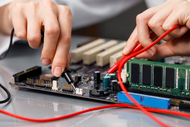J-STD-001 Soldering: Requirements and Best Practices
Posted by Staff - Soldertraining on Mar 16th 2023
Soldering is a crucial operation in the electronics industry, and it takes a lot of practice and attention to detail to do it well. J-STD-001 is a standard in the electronics industry that specifies what tools, materials, and methods must be utilized during the soldering process. An investment in a j-std-001 training kit ensures that your product will function flawlessly in accordance with the requirements of the standard.
Requirements for J-STD-001 Soldering
● Materials
The solder, flux, and cleaning chemicals that can be used during the soldering process are all detailed in J-STD-001. For successful soldering, all materials utilized must be compatible with each other and the substrate. The melting point, composition, and flux content of the solder used must also conform to standards.
● Equipment
Soldering to J-STD-001 standards requires specific tools in good working order. Soldering irons, soldering stations, cleaning tools, and testing tools all fall under this category. Accurate and trustworthy results may only be obtained with equipment that has been regularly serviced and calibrated.
● Procedures
J-STD-001 outlines the required actions for cleaning and inspecting work after soldering, as well as the order in which those tasks must be completed. Adherence to these steps is essential for achieving predictable outcomes.
● Quality Control
To guarantee the soldering process is up to par with J-STD-001, stringent quality control methods are needed. This includes inspecting and testing soldered junctions and monitoring the process to ensure the right materials and methods are employed.
Best Practices for J-STD-001 Soldering
● Ensure Cleanliness
Soldering should only be attempted after the soldering surfaces have been thoroughly cleaned and dried. Solder won't adhere correctly to the surface if there's any residue there, thus the joints won't be strong or reliable.
● Use Appropriate Flux
The quality of a soldered junction is directly related to the type of flux employed. For successful soldering, it is important to use a flux that is both safe for the materials being joined and effective at removing any oxidation from the surface. It is important to apply the flux at the right time and in the right amount to ensure that the solder will stick properly.
● Use the Right Solder
Solder types are outlined in J-STD-001, and it is important to select the correct solder for the materials being soldered. Assuring strong, durable joints requires solder with the right melting point, flow characteristics, and strength.
● Maintain Proper Temperature
To guarantee proper melting and flow of the solder, the soldering temperature must be kept within the required range. Incomplete melting and poor adhesion can occur at too low of a temperature, while damage to the components or PCB can occur at too high of a temperature.
● Inspect and Test Soldered Joints
When checking that soldered connections are up to J-STD-001 standards, it is essential to perform a visual inspection afterward. As part of this process, you should inspect the part for obvious flaws like voids and cracks, as well as for appropriate alignment and solder coverage.
Conclusion
You can make sure your soldering procedure is up to par by adhering to the guidelines laid forth in the standard and employing best practices for soldering, which will lead to sturdy and durable connections.

